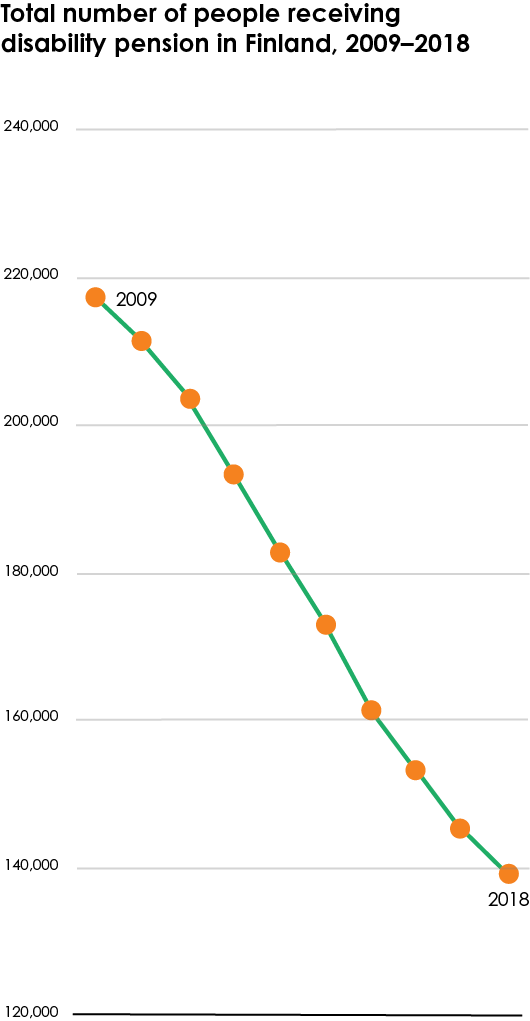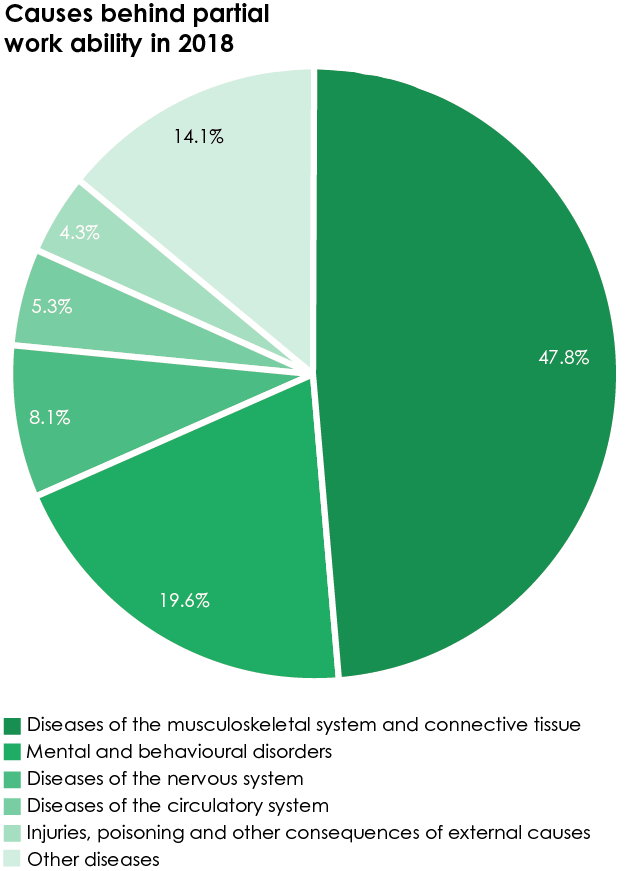People with partial work ability have an important role to play when it comes to bringing their talent to the table in work life. Finland has already made a great deal of progress with employing people with partial work ability.
As the word suggests, a person with partial work ability has only partial ability to do work. In some careers, a person with partial work ability might be fully capable of working, or the partial work ability could be temporary.
This hasn’t gone unnoticed by employers whose preconceptions of people with partial work ability have clearly changed for the better over the last ten years. While previous attitudes towards people with partial work ability were cautious, employers’ opinions have clearly become more positive in the 2010s.
Good news for employment
According to a study carried out by the Ministry of Economic Affairs and Employment in 2017, about 80% of employers considered motivation and competence to be more important than partial work ability during the recruitment process. Finnish companies that had experience with hiring people with partial work ability rated their work motivation to be very high. Many considered the recruitment process to be successful and said that they would also consider hiring people with partial work ability in the future.

Positive experiences and changing attitudes are visible in employment rates in a positive manner: The number of unemployed people with partial work ability has decreased in Finland for three consecutive years, altogether by 30.2%. This means that in 2019, over 12,000 more people with partial work ability were a part of the Finnish work force than in 2015.
At the moment, the increased employment of people with partial work ability is estimated to save about 100 million euros annually.
Flexibility helps and prevents
This positive development is a sum of many factors, but the one common denominator has been the ‘Career opportunities for people with partial work ability’ (OTE) key project launched by the Finnish government between 2016-2018. During the project, employment opportunities for people with partial work ability were improved e.g. by changes in legislation and the training of 700 new work ability coordinators that work in the private, municipal and state sectors.
The diversification of the work life and more flexible careers than before have also had a positive impact, in particular, on the employment of those people with partial work ability for whom the possibility to work remotely or have shorter work weeks are a necessity for being able to work. Ten years ago, about 66% of the people on partial disability pension were working part-time during their retirement; now the same figure is almost 80%.
By flexibly combining work and everyday life and arranging special accommodations for each employee, it is also possible to prevent work disabilities that stem from burn-out or other mental health issues, which, in the 2020s, are one of the most significant causes for inability to work.
Small and medium-sized companies best at employment
The biggest employers of people with partial work ability have been private companies; people with partial work ability have been employed in all sectors. In particular, small and medium-sized companies have employed more people with partial work ability. In large companies, the situation is different for one reason: Companies that are considered to be large are obligated to pay some of the real pension costs for their employers who are on disability pension, which makes the employment of people with partial work ability risky for large companies.
In addition to prejudice and lack of information, one of the most typical reasons to not employ people with partial work ability are the employer’s estimated risks. Because of this, the OTE key project initiated a change in legislation dictating longer trial periods, which has been received with enthusiasm among employers. The legislation came into force at the beginning of 2017 and it has incentivized employers to recruit people with partial work ability by offering employers the choice for longer trial periods and possibilities to extend the trial period if an inability to work causes the employee to be absent during the trial.
Important group for achieving employment goals
Increasing the rate of employment for people with partial work ability is an integral part of the Finnish welfare society, according to the Ministry of Social Affairs and Health. Employing people with partial work ability plays a significant role in the government’s aim to achieve an employment level of 75%.

In financial terms, it is estimated that employing people with partial work ability has a 1.3 billion euro annual potential. The calculation is based on an estimate that there are 65,000 people in Finland who are partially able to work, but who have the motivation and skills to work in a way in which they could be earning 20,000 euro more annually. In reality, the unutilized potential is significantly bigger since the calculation doesn’t consider value creation from employment, nor societal savings coming from unpaid unemployment benefits. In 2018, the state paid over 1.8 billion euros for disability pensions.
Employment opportunities for people with partial work ability have become an important issue everywhere in Western Europe. Because the number of people with partial work ability varies by country, it is hard to compare different countries. In Finland, no official definition of partial work ability exists, and people with partial work ability have not been registered. However, according to the Ministry of Social Affairs and Health, the rate of employment of people with partial work ability is estimated to be one of the highest in Europe.
Perspectives for employers:
- Employing people with partial work ability is a responsible way of employment.
- Preventative action plays an important role in maintaining a person’s ability to work.
- People with partial work ability are a significant yet underutilized potential for the Finnish economy.

Facts about partial work ability
• Partial ability to work shows in many ways: it might be caused by an injury or disability, chronic illness or recovery from a serious illness or a life crisis. Partial work ability is always evaluated on a case-by-case basis, while considering the requirements of the work. Given an appropriate job, a person with partial work ability can be fully able to work.
• According to an estimate by the Ministry of Social Affairs and Health, approximately 600,000 Finnish people feel that their health restricts their ability to work. Approximately 140,000 of them are on full or part-time disability pension and about 300,000 are working.
• In addition, it is estimated that there is a large number of people among the unemployed and outside of work ability services that are not able to work or whose work ability could be improved with rehabilitation.
• The number of people receiving disability pension has been experiencing a stable decline for the past ten years. However, in 2018, the number of people who were on disability pension for the first time increased by 6.5%, compared to the previous year. One thing that might explain the change is the activation model for unemployment security that came into force on January 1, 2018, that defined unemployment benefits and excluded those who receive disability pension. The activation model was abolished on 1 January 2020.
• In 2018, over half of disability pensions were granted as rehabilitation benefits to people who were considered to be able to return to work life fully or partially able to work after rehabilitation. In 44% of the cases, the cause for disability pension was a mental illness.
• Spring House Ltd as a part of the StaffPoint group is an occupational rehabilitation service provider for workplace pension providers, insurance companies, the Social Insurance Institution of Finland, and from the beginning of 2020 for the public sector pension provider Keva. Spring House also offers employment services for people with partial work ability.
This article was firts published in StaffPoint White Paper 2020: Giving Positive Spin to Worklife. Download the free publication.




